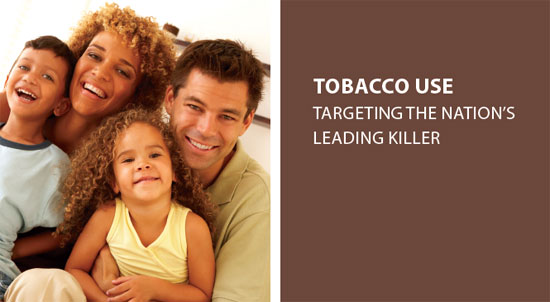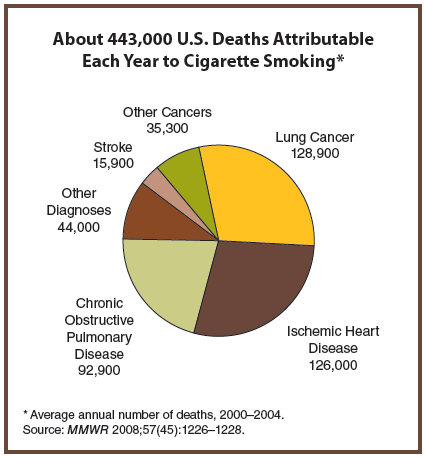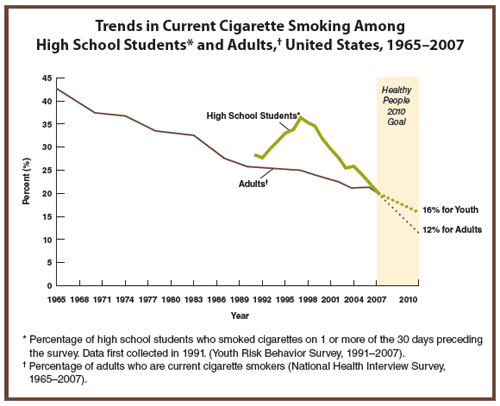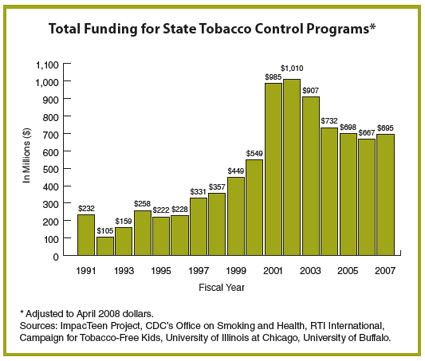 |

|
 |
 |
 |
TOBACCO USE:
Targeting the Nation’s Leading Killer
At A Glance
2009

The Burden of Tobacco Use
Tobacco use is the single most preventable cause of disease, disability,
and death in the United States. Each year, an estimated 443,000 people die
prematurely from smoking or exposure to secondhand smoke, and another 8.6
million have a serious illness caused by smoking. For every person who dies
from smoking, 20 more people suffer from at least one serious
tobacco-related illness. Despite these risks, approximately 43.4 million
U.S. adults smoke cigarettes. Smokeless tobacco, cigars, and pipes also have
deadly consequences, including lung, larynx, esophageal, and oral cancers.
The harmful effects of smoking do not end with the smoker. More than 126
million nonsmoking Americans, including children and adults, are regularly
exposed to secondhand smoke. Even brief exposure can be dangerous because
nonsmokers inhale many of the same carcinogens and toxins in cigarette smoke
as smokers. Secondhand smoke exposure causes serious disease and death,
including heart disease and lung cancer in nonsmoking adults and sudden
infant death syndrome, acute respiratory infections, ear problems, and more
frequent and severe asthma attacks in children. Each year, primarily because
of exposure to secondhand smoke, an estimated 3,000 nonsmoking Americans die
of lung cancer, more than 46,000 (range: 22,700–69,600) die of heart
disease, and about 150,000–300,000 children younger than 18 months have
lower respiratory tract infections.
Coupled with this enormous health toll is the significant economic burden
of tobacco use—more than $96 billion per year in medical expenditures and
another $97 billion per year resulting from lost productivity.

[A text
description of this graph is also available.]
The Tobacco Use Epidemic Can Be Stopped
A 2007 Institute of Medicine (IOM) report presented a blueprint for
action to “reduce smoking so substantially that it is no longer a public
health problem for our nation.” The two-pronged strategy for achieving this
goal includes not only strengthening and fully implementing currently proven
tobacco control measures, but also changing the regulatory landscape to
permit policy innovations. Foremost among the IOM recommendations is that
each state should fund a comprehensive tobacco control program at the level
recommended by CDC in Best Practices for Comprehensive Tobacco Control
Programs–2007.
Evidence-based, statewide tobacco control programs that are
comprehensive, sustained, and accountable have been shown to reduce smoking
rates, tobacco-related deaths, and diseases caused by smoking. A
comprehensive program is a coordinated effort to establish smoke-free
policies and social norms, to promote and assist tobacco users to quit, and
to prevent initiation of tobacco use. This approach combines educational,
clinical, regulatory, economic, and social strategies.
Research has documented the effectiveness of laws and policies to protect
the public from secondhand smoke exposure, promote cessation, and prevent
initiation when they are applied in a comprehensive way. For example, to
prevent initiation, states can increase the unit price of tobacco products;
implement smoking bans through policies, regulations, and laws; provide
insurance coverage of tobacco use treatment; and limit minors’ access to
tobacco products.
If the nation is to achieve the objectives outlined in Healthy People
2010, comprehensive, evidence-based approaches for preventing smoking
initiation and increasing cessation need to be fully implemented.
CDC's Response
CDC is the lead federal agency for tobacco control. CDC’s Office on
Smoking and Health (OSH) provides national leadership for a comprehensive,
broad-based approach to reducing tobacco use. A variety of government
agencies, professional and voluntary organizations, and academic
institutions have joined together to advance this approach, which involves
the following activities:
- Preventing young people from starting to smoke.
- Eliminating exposure to secondhand smoke.
- Promoting quitting among young people and adults.
- Identifying and eliminating tobacco-related health disparities.
Essential elements of this approach include state-based, community-based,
and health system-based interventions; cessation services; counter
marketing; policy development and implementation; surveillance; and
evaluation. These activities target groups who are at highest risk for
tobacco-related health problems.
Sustaining State Programs
CDC continues to support comprehensive programs to prevent and control
tobacco use in all 50 states, the District of Columbia, 7 U.S. territories,
and 7 tribal-serving organizations. In addition, CDC funds national networks
to reduce tobacco use among specific populations. CDC also provides funding
to 22 state education agencies and 1 tribal government for coordinated
school health programs to help prevent tobacco use.
CDC publishes and disseminates accepted best practices to help states
plan, implement, evaluate, and sustain their own tobacco control programs
and also provides technical assistance and training in these efforts.
Expanding the Science Base
CDC is responsible for conducting and coordinating research,
surveillance, laboratory, and evaluation activities related to tobacco and
its impact on health. For example,
- CDC provides guidance, funding, and technical assistance to help
states evaluate their tobacco prevention and control programs. CDC
conducts the National Youth Tobacco Survey and assists with the
state-based Youth Tobacco Survey and Adult Tobacco Survey. CDC also
develops survey instruments and methods to help assess tobacco use in
specific populations.
- CDC conducts global tobacco control activities with international,
regional, and country-specific partners. CDC, the World Health
Organization, and the Canadian Public Health Association have developed
the Global Tobacco Surveillance System, which now includes the Global
Adult Tobacco Survey, funded through the Bloomberg Global Initiative to
Reduce Tobacco Use.
- CDC’s Division of Laboratory Sciences and OSH evaluate additives and
chemical constituents of tobacco and tobacco smoke.

[A text
description of this graph is also available.]
Communicating Information to the Public
CDC translates research into practice by keeping the public, policy
makers, health professionals, and partners informed about current
developments and initiatives in tobacco control.
- CDC responded to about 42,000 tobacco-related inquiries in Fiscal
Year 2008 (FY 2008) and distributed nearly 992,000 publications and
video products. About 5.6 million people visited CDC’s new Smoking &
Tobacco Use Web site in FY 2008.
- CDC works with other federal, state, and local agencies to provide
materials and resources to educators, employers, public health workers,
the media, and other community leaders who are working to prevent
tobacco use.
- Through the Media Campaign Resource Center (MCRC) and the Cessation
Resource Center (CRC), CDC helps states stretch their media budgets by
using and adapting existing ads and other materials rather than creating
new ones.
Promoting Action Through Partnerships
CDC works with a variety of national and international
partners to ensure that diverse groups are involved in tobacco control
efforts. For example,
- CDC is the lead agency for the 21 national objectives on tobacco use
in Healthy People 2010.
- CDC staffs the U.S. Department of Health and Human Services’
Interagency Committee on Smoking and Health, which coordinates research
programs among federal, state, local, and private agencies.
- CDC coordinates and promotes tobacco prevention and control
activities with partners, including the American Cancer Society,
American Heart Association, Americans for Nonsmokers’ Rights, American
Legacy Foundation, American Lung Association, Campaign for Tobacco-Free
Kids, National Cancer Institute, Robert Wood Johnson Foundation,
Substance Abuse and Mental Health Services Administration, Tobacco
Technical Assistance Consortium, U.S. Environmental Protection Agency,
World Bank, and numerous national networks.
- CDC, in partnership with the National Cancer Institute, the North
American Quitline Consortium, and state tobacco control programs, has
developed the National Network of Tobacco Cessation Quitlines. By
calling 1-800-QUIT NOW, callers from across the nation have free and
easy access to tobacco cessation services in their state.
Future Directions
CDC will continue to work with policy makers, health officials,
partners, and the public to ensure that tobacco control remains a core
component of public health domestically and globally. Agency priorities
include the following:
- Identify the determinants of the stalling decline in youth smoking
rates.
- Sustain and expand the capacity and reach of quitlines.
- Advance the implementation of smoke-free policies.
- Identify and disseminate the evidence base needed to reduce
tobacco-related disparities.
- Help states increase resources for comprehensive tobacco control
programs.
- Investigate the public health implications of smokeless tobacco use.
Back to top
Success Stories
Alaska
Rates of tobacco use, both cigarettes and spit, have historically been
higher in Alaska than in the rest of the nation. These rates are especially
pronounced in the Alaska Native population, which has significantly higher
rates of tobacco use than whites and other racial or ethnic groups in the
state. Tobacco use costs the state more than $148 million in lost
productivity and more than $132 million in health care costs annually.
To address this health problem, the Alaska Department of Health and
Social Services has implemented a comprehensive tobacco control program
based upon CDC’s Best Practices for Comprehensive Tobacco Control
Programs—2007. Program components include countermarketing,
community-based programs, youth and school programs, eliminating exposure to
secondhand smoke, eliminating health disparities, cessation, and evaluation.
The program includes a free quitline for all Alaskans (1-888-842-QUIT) that
includes individualized quit plans, personal quit coaches, and nicotine
replacement therapy. Thousands of Alaskans have called the quitline since it
was established in 2002, and a 2007 study documented a 40% quit rate.
Program components have been implemented in partnership with the Alaska
Tobacco Alliance, local tobacco prevention and control coalitions, nonprofit
and Alaska Native organizations and individuals, and schools, with support
from legislators and local governments who have supported tobacco-use
prevention efforts.
Alaska has seen progress as a result of its efforts. Data from the 2008
Alaska Behavioral Risk Factor Surveillance System, showed a significant
reduction in tobacco use. The percentage of adult smokers in Alaska has
declined by one-fifth since 1996 to 21.5% in 2007. This figure represents
more than 27,000 fewer smokers and is expected to result in almost 8,000
fewer tobacco-related deaths and $300 million in averted medical costs. The
data indicate that smoking is declining among adults in most age groups and
regions of the state. Although smoking rates are still high among Alaska
Native adults, they have dropped significantly among Alaska Native youth.
These decreases in smoking rates demonstrate the effectiveness of
Alaska’s comprehensive program. Reducing tobacco use in the Alaska Native
population has long been a serious public health challenge, and any progress
toward reducing prevalence rates in this population is a clear and
measurable accomplishment. The recent increase in the Alaska program’s
funding demonstrates the support in state government for tobacco control
programs that are proven to be effective.
Navajo Nation
Commercial tobacco-use prevalence rates are much higher in American
Indian and Alaska Native populations than in the U.S. population as a whole.
Some tribes have prevalence rates as high as 40%. However, efforts to reduce
commercial tobacco consumption must be implemented in a culturally sensitive
way to distinguish traditional or ceremonial use from commercial use.
The Navajo Nation Council proposed the Navajo Nation Commercial
Tobacco-Free Act of 2008, which prohibited all commercial tobacco use,
including cigarettes, pipes, cigars, and smokeless tobacco. The legislation
would have made all “public places, places of employment, and shared public
airspace within the Navajo Nation” 100% commercial tobacco-free.
The Tribal Council passed the legislation without proposed amendments
that would have weakened it by exempting casinos, resorts, sporting arenas,
and golf courses. However, the legislation was vetoed by the Navajo Nation
president, and a subsequent attempt to override the veto was unsuccessful.
Although the legislation did not pass, the effort focused attention on
commercial tobacco use in the Navajo Nation and possibly throughout other
sovereign tribal nations. The partners who came together for this effort
plan to try again in the future.
New York
More than 25,000 New Yorkers die from tobacco use each year, and the
state annually incurs more than $8 billion in medical costs related to
tobacco use. In response, the New York Tobacco Control Program (NYTCP)
established several ambitious goals, endorsed by the governor, to achieve by
2010—1 million fewer smokers, an adult prevalence rate of 14%, and a youth
prevalence rate of 10%. Reaching these goals will require a comprehensive,
evidence-based tobacco-control effort that focuses on sustaining funding and
infrastructure.
According to CDC’s Best Practices, the State of New York should be
funding its tobacco control program with $254.3 million each year. Although
tobacco control funding in the state falls short of this recommendation, New
York has seen an impressive increase in recent years—from $32.5 million in
2000 to $85.5 million in 2007. How did New York achieve such an increase—and
sustain it—at a time when so many states have seen budgets drastically
reduced?
NYTCP began requiring funded community partners to implement
sustainability plans and to report on their activities. These sustainability
activities include monthly communication with local legislators, including
in-person office visits, as well as outreach to the media through letters to
the editor and personal stories from those affected by tobacco use. The
Center for a Tobacco Free New York and its partners also aggressively
advocated for increases in the tax on tobacco products to bring funding for
the statewide program closer to CDC-recommended levels. Independent
evaluation reports of the statewide program have been published annually for
the past 4 years, and the results of the program’s effectiveness are shared
widely with legislators and other decision makers.
Through these efforts, NYTCP and its partners—national tobacco control
experts, independent evaluators, state-funded community representatives,
policy makers, and the public—have been successful in repeating simple and
direct key messages:
- Tobacco use is an epidemic that adversely affects every community in
the state.
- Tobacco control works. New York is effectively implementing
evidence-based interventions that get results. Prevalence in New York is
lower than the national average—18.2% for adults and 16.2% for high
school students.
- Evidence demonstrates that the longer states invest in comprehensive
tobacco control programs the greater the impact. These programs also
become more cost-effective over time.
- A huge unmet need exists, which can be better addressed with more
financial resources.
In New York, tobacco is an $8 billion problem—with a $250 million
solution.

[A text
description of this graph is also available.]
Back to top
Related Materials
Back to top
|
For more information or copies of publications referenced
in this document, please contact
Centers for Disease Control and Prevention
National Center for Chronic Disease Prevention and Health Promotion
4770 Buford Highway NE, Mail Stop K–50, Atlanta, GA 30341-3717
Telephone: 800-CDC-INFO (232-4636) • TTY: 888-232-6348
E-mail: cdcinfo@cdc.gov • Web:
http://www.cdc.gov/tobacco
|
|
 One or more documents on this Web page is available in Portable Document Format
(PDF). You will need Acrobat
Reader (a free application) to view and print these documents.
One or more documents on this Web page is available in Portable Document Format
(PDF). You will need Acrobat
Reader (a free application) to view and print these documents.
Page last reviewed: January 29, 2009
Page last modified: January 29, 2009
Content source: National Center for
Chronic Disease Prevention and Health Promotion
|
|

![]() One or more documents on this Web page is available in Portable Document Format
(PDF). You will need Acrobat
Reader (a free application) to view and print these documents.
One or more documents on this Web page is available in Portable Document Format
(PDF). You will need Acrobat
Reader (a free application) to view and print these documents.